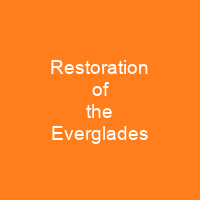Restoring the Everglades: A Long-Term Battle Against Time and Industry
The Everglades, a vast and unique ecosystem that has been under threat for decades, is now at the center of an ongoing restoration effort. Can we truly restore what was lost? And how much can we really change when faced with powerful industries and political pressures?
A Historical Overview: From Drainage to Restoration
For centuries, the Everglades have been a subject of interest for agricultural development. The 19th century saw various attempts at draining and canal construction, leading to tourism and real estate growth. However, these efforts came with catastrophic consequences for the environment.
The Central and Southern Florida Flood Control Project: A Double-Edged Sword
Established in response to floods caused by hurricanes in 1947, the C&SF project resulted in 1,400 miles of canals and levees. While these projects aimed to control flooding, they had devastating effects on animal habitats and water quality.
The Everglades Forever Act: A Step Forward?
In the 1980s, high levels of phosphorus and mercury were discovered in waterways, leading to costly court battles. The Everglades Forever Act, passed in 1994, aimed to set deadlines for pollutant levels to decrease. However, critics argued that it delayed enforcement until 2006 and did not require enough costs from sugarcane farmers.
The Comprehensive Everglades Restoration Plan: A Decade-Long Journey
Enacted in 2000, the CERP was a comprehensive strategy to address the issues. It aimed to restore damaged areas over 30 years at a cost of $7.8 billion. Despite being passed into law, the plan has been compromised by political and funding issues.
The Sugar Industry’s Role: A Controversial Player
The sugarcane industry, dominated by U.S. Sugar and Flo-Sun, was responsible for over half of the crop in the Everglades Agricultural Area (EAA). They resisted efforts to correct phosphorus levels, leading to ongoing conflicts with conservationists.
Mercury Pollution: A Hidden Threat
In the 1980s, mercury pollution became a concern. Warnings for fishermen and scientists were issued when a Florida panther was found dead with high mercury levels. The source of the mercury was traced to waste incinerators and fossil fuel power plants.
Exotic Species: A New Challenge
The introduction of exotic plant and animal species, such as melaleuca trees, Brazilian pepper, and Old World climbing fern, has caused significant harm. These invasive species have choked out native vegetation, made it difficult for birds to nest, and altered natural water flow.
Urbanization: A Growing Threat
Urban development in South Florida between 1940 and 1965 led to the introduction of exotic species. The Florida panther is particularly threatened by urban encroachment, with only 80-120 individuals remaining as of 2008.
Bipartisan Support: A Temporary Win?
Restoration briefly became a bipartisan cause in national politics. However, the proposed tax on sugar was rejected due to lobbying efforts from the industry. Congress approved funding for land acquisition, but implementation has been hindered by political maneuvering and lack of funding.
The Restudy: A Comprehensive Strategy
A 1999 report known as the ‘Restudy’ evaluated the effectiveness of the C&SF project. It recommended a comprehensive strategy to address issues, which would cost $7 billion over 20 years. The plan includes constructing surface water storage reservoirs and preserving areas.
The Future: A Hopeful Vision?
The ‘restored’ Everglades will be smaller but successfully restored, with recovered hydrological and biological patterns defining its uniqueness among wetland systems. However, critics express concerns over unused technology, aquifer overtaxing, and irreversibility of physical changes to the ecosystem.
Conclusion: A Continuous Struggle for Balance
The restoration of the Everglades is a complex and ongoing process. Can we truly restore what was lost? The answer lies in our commitment to balance natural needs with urban and agricultural growth, and in our willingness to face powerful industries and political pressures.

You want to know more about Restoration of the Everglades?
This page is based on the article Restoration of the Everglades published in Wikipedia (retrieved on December 1, 2024) and was automatically summarized using artificial intelligence.







